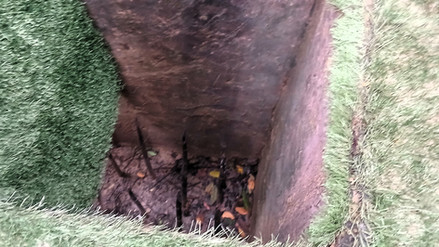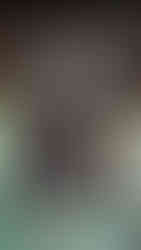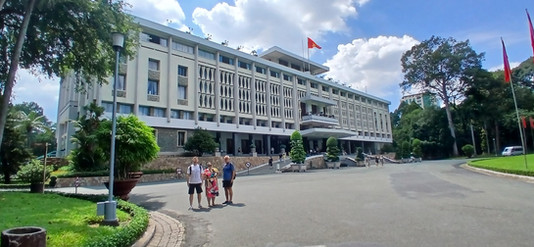Ho Chi Minh City, Vietnam (2)
- Julie-Anne Justus

- Nov 2, 2024
- 6 min read
Updated: Nov 2, 2024
The area we're in is about 50 km north-west from Ho Chi Minh City. It's called Cu Chi, pronounced goo-chi. Here we're also close to the Cambodia border and close to the Ho Chi Minh trail where weapons and supplies for the wars were transported through the Cambodian jungle (often on bicycles) from the north of Vietnam to the south.
Those weapons would have included Russian AK-47s, which I had a go at firing. I also had a go at firing an M16, not that I noticed any difference (being generally ignorant about assault weapons). Was I hitting any targets? I'm short-sighted so I could hardly see them, never mind hit them.

Always, the abandoned hardware from the wars.
Cu Chi is particularly famous for its network of tunnels. These tunnels were the base for the Viet Cong's military operations in the south. The Viet Cong fighters lived in the tunnels, hid in the tunnels, used the tunnels as supply routes and hospitals, and stored food and weapons in the tunnels.
Our 23 year old guide, Phong, told us that the people in the north of Vietnam are the custodians and preservers of culture and tradition. Traditionalists in the north believe that Cu Chi is sacred ground, where patriots' blood was spilled defending their country from the invaders. They believe that the area should be treated as hallowed ground, like a graveyard.
But, said Phong, the people in the south are more interested in money. So local councils have turned this area into a tourist attraction, including (rather oddly) a water park. It's very popular with visitors.
The photo below shows a model of the tunnels, designed to withstand enemy bombardment as well as intrusion by people and gas. But not snakes, scorpions and rats, which loved the tunnels. Mosquitoes as well — later records show that malaria caused almost as many deaths as battle wounds.

Notice the rules below. You're warned not to go down the tunnels if you're of old age (helpfully defined as 70 years or more) or drunk on alcohol or beer. Since my sister and I are not yet of old age, and we were not drunk on either alcohol or beer, we tackled the tunnels.

The tunnels that tourists visit are part of a much larger network that threads throughout the country. These particular tunnels have been made wider and more stable for tourists. But it was very hot down there, very dark and very stuffy. And these had been touristified! The mind boggles.
Obviously, during the time of war, the entrances didn't have a nice little thatch roof and neatly fashioned steps. The whole point was to make them difficult for the enemy to see. Like this.
The tourist area is quite extensive. It includes a number of these model scenes depicting 'typical' Viet Cong combatants. Being guerilla fighters, they did not wear uniforms, so they looked like every other Vietnamese civilian. Boots were in short supply so everyone wore sandals made from old bicycle tyres. They might have been women or men, children or adults, old people or teenagers. Anyone could be a Viet Cong member. That was one of many things that spooked the Americans: determining who was on-side and who was off-side.
There were no field hospitals or weapons facilities above ground. They were all below ground. We descended into the tunnels again to get to the main war conference room, where the leaders planned their next campaigns. It was very dark — a grim atmosphere.
But that wasn't all. If a fighter didn't emerge unexpectedly from the ground in front of you, or a sniper shoot at you from peep-holes throughout the jungle (from underground, in the tunnels) or peep-holes disguised as rocks (no, wait, that was a ventilation hole) ...
... then you had to be careful of stepping on booby traps, like these beauties. The traps would be well disguised and difficult to spot in the jungle. (Not like these displays with artificial grass, which look like a diabolical mini-golf course.) The bamboo punji sticks at the base of the traps or on revolving axles were tipped with plant poison, snake venom or human excrement, which would either kill you instantly or infect and rot your body.
I thought often of naive young American men from the plains of Oklahoma or the snows of Minnesota who had never been out of their hometown being dropped into this environment. Or the Tunnel Rats, the young soldiers who were sent into the tunnels to flush out the Viet Cong. The Australian Army was the first to send in the 'rats' — apparently they called them 'tunnel ferrets' but the Americans didn't know what ferrets were so they became 'rats'. Mortality rates were high and in later years, those who survived were disproportionately affected by Agent Orange, because of their close contact with the soil and tunnel air saturated with the poison.
What a war, hey.
Fast forward to 1975. The war in the south is lost, the USA has fled, and two North Vietnamese tanks come busting through the gates of the Independence Palace in (then) Saigon. Here are the tanks ...
... and here is the Palace. It's a grand old place.
Here's the lovely view from the first floor balcony. See the tanks on the left?

Inside it's as you'd expect of a government building: reception rooms, conference rooms, state dining rooms — all very grand. It struck me how light and bright the rooms are, with the natural sunlight pouring through.
The presidential reception rooms would have hosted some interesting personalities over the years. Imagine the 1970s, with guests like Richard Nixon and Henry Kissinger. If walls could talk ...
My favourite reception room is the Ambassadors Chamber. It has an elegantly oriental style, and I reckon I could spend time in here very happily. I'd quite like to be an ambassador.
One has to imagine government officials being holed out in this building (not quite the tunnels, right?) trying to manage the war effort, encourage the populace and convince foreign governments to keep funding them. That's not hard to imagine since we have similar events happening right now elsewhere in the world.
To cheer everyone up, there are some more entertaining rooms. There's the trophy room, the home theatre, the games room ... all looking very 1970s. And no computer or TV screens! There's also a firing range in the basement, if you're so inclined. Not that I think that's entertainment, under these circumstances.
Now to the top of the building, where a Huey helicopter was parked permanently in case the president had to flee, or go shopping. Kidding. I was reminded of the famous scenes of helicopters pulling desperate civilians off the roof — but that was the US Embassy. Not the same building or roof! This roof is famous for being bombed by a renegade South Vietnamese pilot. The red circles on the roof show where the bombs landed.
The room on the top of the roof was intended by the architect as a space for meditation, for calm reflection about government decisions. Instead, points out the writer of the information board reprovingly, it was turned into a party room. Of the dance type, not the political type.

While the diplomatic work was being done in those grand rooms, the nitty-gritty work was being done in these rooms. It's quite extraordinary seeing paper maps and hand-written notes in these days of everything digital. And look at that array of pretty and colourful telephones!
And finally, the bunker! So I guess it wasn't only the Viet Cong who was underground ...
These rooms contain the height of modern communications equipment in the 1970s. It's archaic but not unfamiliar — perhaps because we've seen so many movies and TV shows set in this era and featuring this type of equipment.
Also in the basement are garages for a few vehicles and an industrial-sized kitchen. Anyone else detect a note of slight reproach about the president's daughter's wedding? Sub-text: Partying while the patriots were eating rats and mouldy rice ...
So there we have it: the contrast between the Viet Cong fighters in the dark and dirty tunnels and a few kilometres away, the rather more luxurious trappings of the South Vietnamese regime. A bit of a simplification, of course. The younger guides we met acknowledge the complexities of their history; they seem forward-looking and not bitter or angry about the destruction of the wars. One of the most endearing things about modern Vietnam is that the casual tourist doesn't encounter anger, lingering resentment or a black-and-white view of the past.
Other countries — and we all know which one, most ironically — could learn from this. But I think that horse has bolted.
Next (and last for this trip): the Mekong River south-east of Ho Chi Minh City.



























































































































































































Comentarios